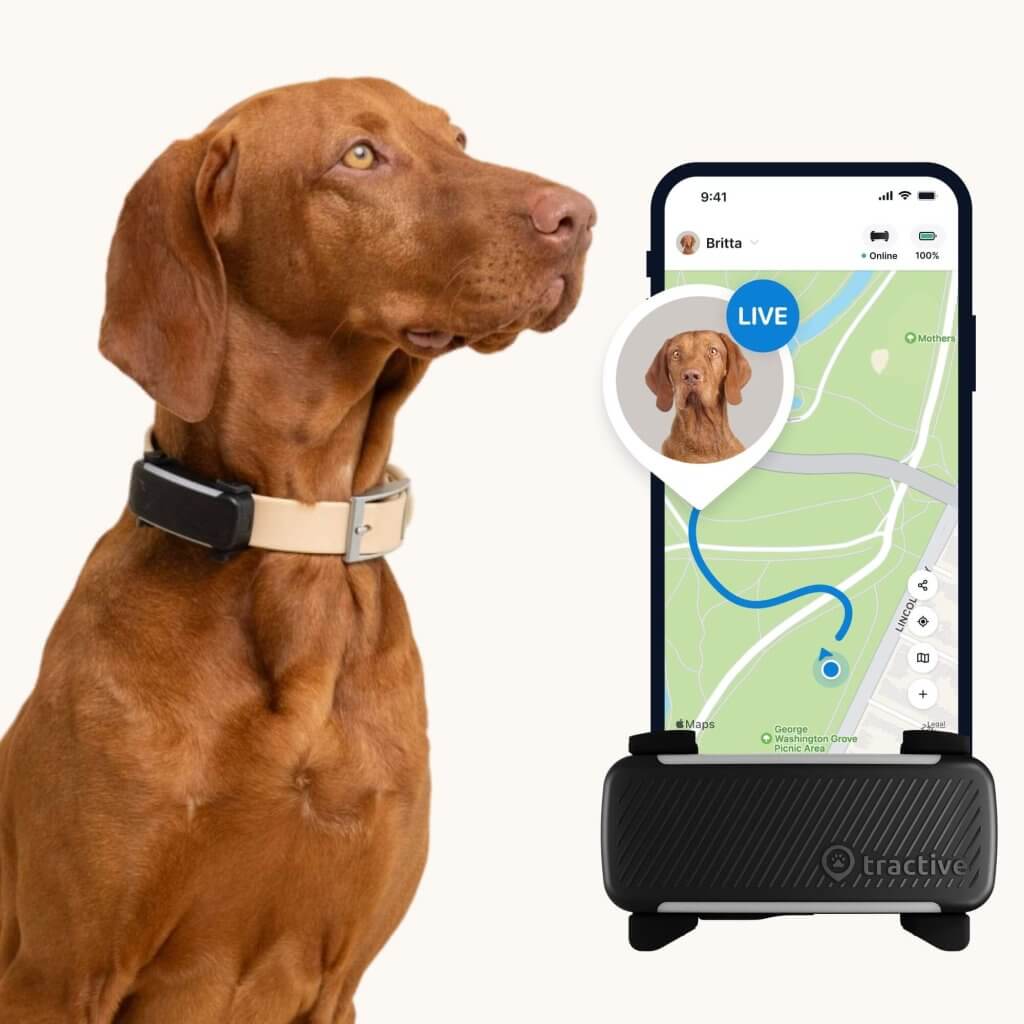Is There A GPS Implant For Dogs That Works Like A Microchip?
You might've heard of GPS trackers for dogs...but is there a possibility you can implant one into your dog's skin like a microchip? Short answer: no. GPS implants for dogs don't exist - and they wouldn't be a safe or healthy option either way.
Have you ever wondered, is there is a GPS implant for dogs? Aka, a GPS tracker that can be implanted under the skin – so it can prevent your dog from getting lost, like a microchip? It does sound pretty ideal – a tool that can both identify AND track down your missing dog, all in one device.
But to answer your question in a nutshell: no, a GPS implant for dogs doesn’t exist yet. And it wouldn’t actually be the best idea for animals in the first place. Here’s why.
Key Takeaways
GPS implants for dogs do not exist and are not a safe or healthy option due to the large size of necessary hardware components (GPS antenna, GSM module, battery pack). You also can’t charge an implanted battery – and you’ll put your dog’s health at high risk if you could.
External pet GPS trackers worn on a collar are the safe and effective method for tracking a dog. They offer features like real-time tracking, unlimited range, and activity monitoring.
Microchips, on the other hand, only help identify your dog and can be implanted in their skin. However, they don’t contain any GPS tracking features and cannot actually, actively help you track down your dog.
At the end of the day, safety first: equip your dog with a microchip AND a GPS tracker to ensure you can always find them.

Always know your buddy is healthy & safe
Read more- Is there a GPS chip for dogs? (And do you even need one?)
- What could a GPS implant for dogs be like? (Theoretically?)
- Is it possible to implant a GPS tracker into my dog?
- Why you can’t implant a GPS tracker into a dog
- Where a smart dog tracker steps in
- Is there ever going to be a safe GPS implant for dogs ?
Is there a GPS chip for dogs? (And do you even need one?)
No, such a device doesn’t exist in the first place. You might be confusing it with microchips instead – which we’ll cover a bit further below. And the good news? You don’t need to implant a GPS tracker into your dog’s skin to find them. A dedicated smart dog tracker that works across an unlimited range and includes real-time tracking works just fine – strapped comfortably to your dog’s collar.
What could a GPS implant for dogs be like? (Theoretically?)
The phrase ‘GPS implant for dogs’ is commonly searched for in search engines every month around the world. But what could such a device for dogs be like, theoretically at least? Let’s take a closer look at this phrase:
- GPS – short for Global Positioning System: a technology which tells you where you are on earth at any given moment¹
- implant – something which has been put into the body in a medical operation²
- for dogs – for our favorite canine friends.
Which raises the question…
Is it possible to implant a GPS tracker into my dog?
The answer is a hard NO – it is not possible to implant a device, which uses GPS technology to track your pet, into your dog at this time. Why? For the same reason such a device is not currently available for humans. Let’s explore this in greater detail.
If microchips can be implanted, why not a GPS tracker?
As a dog parent, it’s very important to understand the difference between the implantable chips that are used for identification of your pet, and GPS trackers – which are another type of technology entirely.

- Microchips firstly can be implanted into your dog’s skin. But they only help a vet or a local shelter identify your dog if they’re lost.
- GPS trackers can’t be implanted into dogs’ skin. But they help you track your dog in real-time and take a more active role in finding them. Usually, you can strap one to your dog’s collar or secure it with zip-ties.
| Details |  Microchip for dogs | Tractive GPS Tracker |
|---|---|---|
| Size | 12 x 2 mm | 71 x 29 x 17 mm |
| Weight | 0,025 g | 39 g |
| Implantable | ||
| Waterproof | ||
| Battery life | No battery included | 7-10 days – or 30 days on the Adventure edition |
| Upfront cost | ~85 € | 49,99 € |
| Ongoing costs | None | Yes – meaning a monthly fee less than your Netflix subscription |
| Location tracking | ||
| Are you going to have to rely on strangers? | Yes | No |
| Real-time location updates | ||
| Legal requirement | Varies from country to country | No |
| Theft insurance | No** | |
| Area of operation | Worldwide | Worldwide |
| Escape alerts | ||
| Activity tracking | ||
| Sleep tracking | ||
| Health alerts | ||
| Light & Sound tracking | ||
| Dog weight requirements | None | From 4 kg/~9 lbs onward |
Why you can’t implant a GPS tracker into a dog
There are several reasons why it is not possible to implant a GPS tracker into a dog at this time. Firstly, think of any device you know of that uses GPS technology – for example a smartphone or automotive navigation system. All of these devices contain other important hardware components that must be built into the device to keep it running. (For example, a battery, or screen to show you the GPS location information.)
So here are two main reasons why these components make it impractical to implant a GPS tracker into your dog’s skin.
Reason 1: Size
The Tractive GPS dog tracker, has dimensions of about 71 x 29 x 17 mm millimeters and weighs approximately 39 grams. Below, you can see the size of the GPS tracker, which easily fits onto your dog’s collar or harness:

Small, compact and lightweight, your dog can comfortably wear their GPS tracker at all times, in the same way that you wear a standard or smartwatch.
⚠️ So imagine the face of a watch being implanted under your skin – ouch! In this way, it would not be comfortable nor safe to implant a GPS tracker into your dog.
By comparison, an implantable ID chip or transponder is about 11 millimeters long and two millimeters thick – nearly the size of a grain of rice. At this size, they can be safely implanted between your dog’s shoulders. It is a simple, electronic chip enclosed in a glass cylinder, as shown in the x-ray photo below.

Why is there a size difference between GPS trackers and implantable chips?
Microchips in general contain an ID number which can be linked to your pet. Meaning, they don’t contain any GPS hardware components or technology. That’s why microchips can afford to be the size of a grain of rice – they don’t come with the features a GPS tracker might. Which explains the first reason why GPS devices cannot be implanted into dogs at this time.
On the other hand, a GPS tracker contains several necessary hardware components, each of which is larger than a grain of rice and therefore contributes to the size of the device. Here are some of the hardware components you’ll find in a GPS tracker:
- GSM module
- GPS antenna
- LED-light
- loudspeaker
- battery pack
Reason 2: Battery & Charging
Standard GPS trackers come with an integrated battery, which you need to charge every now and then. Since the size of the battery is directly related to the battery life of the device, this is the component which takes up the most space inside of the tracker. If you implant this in your dog’s skin – how are you going to charge it? (No way of inserting the USB charging cord, right?)
⚠️ Implanting a lithium-ion battery inside your puppy would likely come with certain health risks as well. It’s one reason why vets discourage the use of Apple AirTags for dogs – because if your buddy chews or swallows the little tag by mistake, it could severely damage their organs.
Technically, there may be a way to integrate the tracker inside your furry buddy – but this is far from a “smart solution”. But at the end of the day: implanting a GPS tracker under your dog’s skin is neither a pet-friendly nor healthy way to keep your pet safe.
Where a smart dog tracker steps in
If you’re concerned about your dog running off or getting lost, a smart dog tracker with real-time GPS tracking can be your key to peace of mind. Loved and trusted by pet parents around the world – just like you – here’s where Tractive can lend a hand. (Or paw.)
Strapped to your dog’s collar, you can now:
- Track your dog in real-time
Via LIVE mode on your Tractive mobile app – and follow your dog’s every step, as they make their every step. Better yet, unlike AirTags, Tractive devices don’t need a network of compatible devices to work. Nor are they limited by any range. - Get alerted if your dog escapes home
By setting up “safe zones” and “no go zones” via your Tractive mobile app. If your dog leaves a safe zone or enters a no-go zone – you’ll get an escape alert on your phone. - Locate your dog at close range
Your trusty Tractive device also includes short-range Bluetooth tracking for areas with poor network or where GPS isn’t helpful. (Like indoors.) So you can locate your dog if they’ve crawled beneth your bed or are hiding somewhere nearby. - Figure out where your dog spends their time
From their Location History. So you can better understand where your dog likes to hunt, hide, or just hang out. Now in an emergency, like if they’ve gone missing, you’ll know where to look first.
Is there ever going to be a safe GPS implant for dogs?
At present, there’s no such thing as a safe GPS implant for dogs available on the market today. While an implantable GPS tracker might be available in the distant future, the technology to make this device small enough, and safe enough, to be implanted into your friend is not available (or affordable) for mainstream use at this time. But even so, we have good news:
💡Both GPS trackers and implants are widely available and necessary and helpful precaution measures to keep your dog safe. You just need to keep them separate so they can both so what they do best.
So if you suspect your dog’s a bit of an escape artist, it’s best to make sure your dog is already equipped and prepared with both a GPS tracker on the collar and a microchip ID implant. This will ensure that if lost, you can track your dog in real-time with Tractive’s LIVE Tracking, or brought into a vet and identified with the help of an RFID chip (if found by someone other than you)

Follow your dog anywhere
Get real-time location information, wherever they go. And find out when they try to make an escape, or just when they go somewhere they shouldn’t, with Virtual Fences.
Found this article helpful? Share it with a fellow tech-savvy dog parent – and let’s help build a safer, kinder world for our furry friends together.



